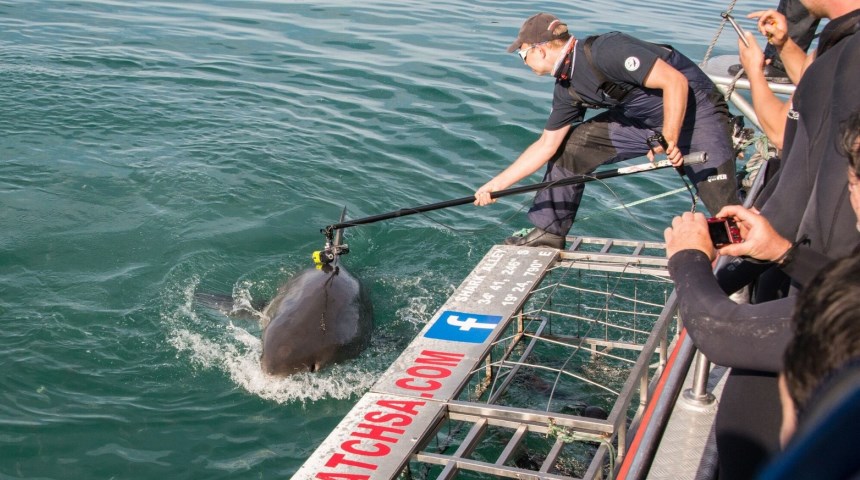
Scientists have attached cameras to large white sharks to reveal their astounding manoeuvrability through densely packed kelp forests while hunting for prey.
Previously, it was thought white sharks waited around the edges of kelp forests to ambush emerging seals because it was assumed the sharks were too big to enter.
But the footage, collected from eight sharks tagged off the South African coast by a team including Murdoch University PhD student Oliver Jewell, show they are able to navigate through tight channels, and barge through large stipes and fronds.
Mr Jewell, who is part of Murdoch’s Centre for Sustainable Aquatic Ecosystems in the Harry Butler Institute, said this behaviour had never been captured on camera before.
“The film we collected gives us a new perspective on this species. We can see how they interact with their surroundings in real time, and they are able to make some pretty spectacular 180 degree turns in the kelp forest,” Mr Jewell said.
“In the past we would have to guess. We would track sharks to the edge of the kelp forest but then lose the signal.
Being able to see what these fish do in this habitat helps to bring another layer of understanding to the behaviour of these ocean giants.
Several Cape fur seals were also captured by the shark cams swimming through the kelp forest in the Dyer Island Marine Reserve. The footage shows them displaying predator evasion techniques such as blowing bubbles in response to the presence of the shark. But the 28 hours of footage collected did not capture any kills in the kelp forest, which may support findings that kelp provides refuge for seals.
Mr Jewell said this behaviour might also be applicable to white sharks patrolling kelp forests off the coasts of California and South Australia, but more research was needed to confirm the behaviour.
To safely attach the cameras, the researchers first needed to entice white sharks to their boat. They placed chum (fish cut into small pieces) in the water and used a seal decoy to attract them close enough, so they could use a fishing rod-like device to carefully clamp the specially mounted camera and motion sensor on to their dorsal fin.
Dr Taylor Chapple, expedition leader from Stanford University, has been studying white sharks for more than 15 years but the wealth of knowledge camera tags provided surprised even him.
“At times we would have to spend many hours at sea, perched over the side of a boat to deploy these tags, with no guarantees to even see a shark. But the incredible data made it all worthwhile,” Dr Chapple said.
“Not only can sharks be tricky to find, attaching the clamps to animals that manoeuvre through kelp proved equally challenging, as the kelp often dislodged the valuable instrument.”
The tags were designed to stay on the sharks for a set number of hours before popping off and being collected at the surface.
While invaluable, Mr Jewell said the footage collected revealed only a small aspect of a white shark’s behaviour.
Scratching the surface
Dr Salvador Jorgensen, a Senior Research Scientist at Monterey Bay Aquarium and a co-author on the study, indicated that some of the camera tags used in this study were test models for future camera tags. Engineered by the Monterey Bay Aquarium Research Institute (MBARI), the tags are capable of submerging to over 1500m.
“In the future we hope these cameras will be used to study the sharks’ mysterious behaviour in the open ocean where they dive repeatedly to great depths,” said Dr Jorgensen.
“We are really only scratching the surface with this study — there are so many layers to their behaviour. In the 15 plus years we’ve been studying them, it’s become clear white sharks are very versatile. They use very different habitats from diving deep into mid-water ocean to ‘bushwhacking’ through coastal kelp forests.
“More research of this nature is needed to help better understand the ocean resources used by this incredible species, so we can inform management and do more to ensure their survival.”
The project was a collaboration between Murdoch University, Monterey Bay Aquarium and Stanford University in California.
The research was published in the journal Biology Letters.